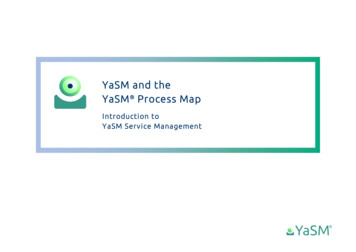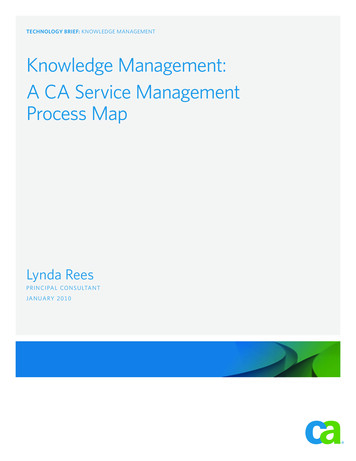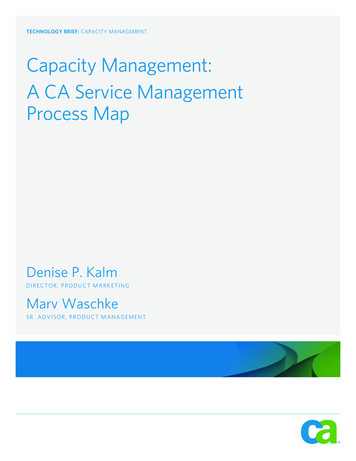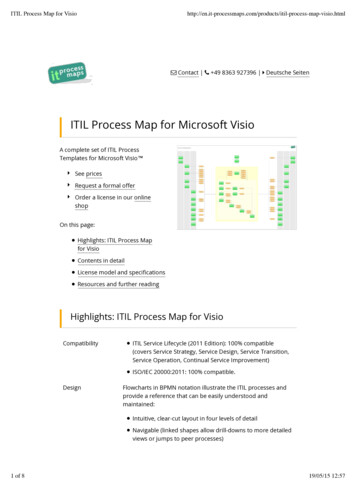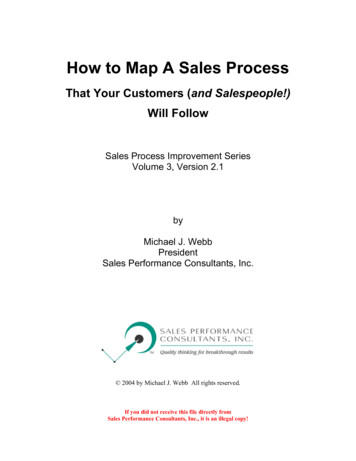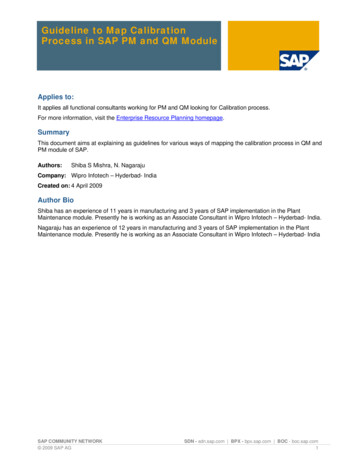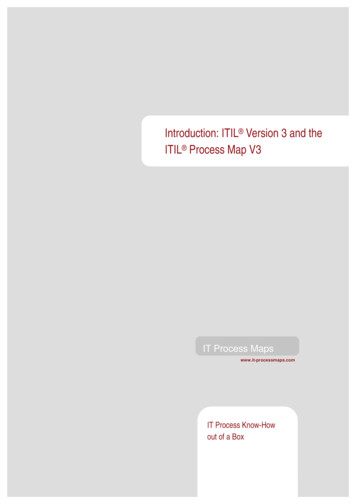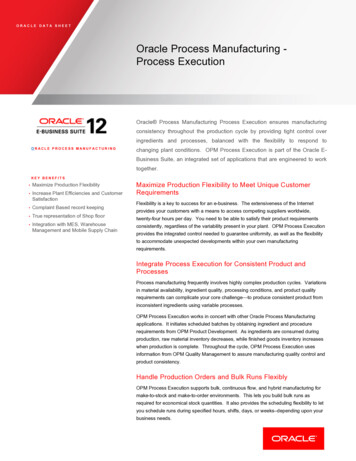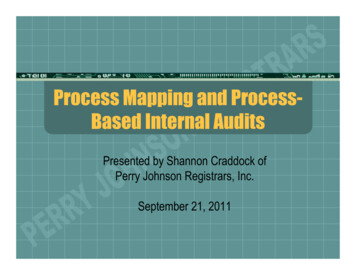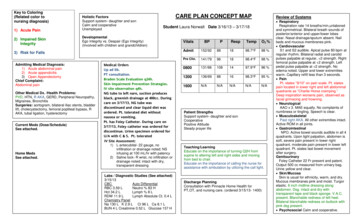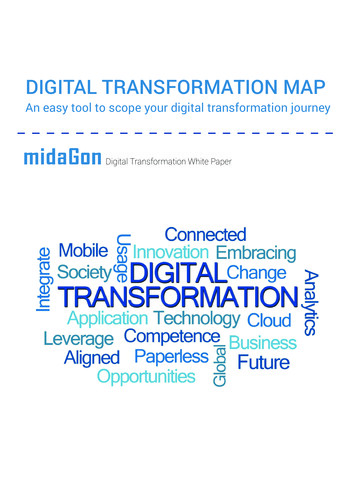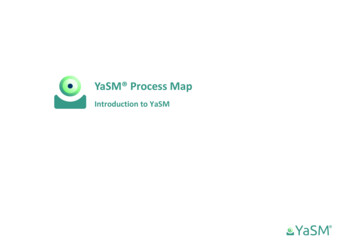
Transcription
YaSM Process MapIntroduction to YaSM
ContentsWhy “Yet another Service Management Model”? . 5YaSM - the idea . 5A framework for everyone in the business of providing services . 6YaSM and other service management frameworks and standards . 6YaSM and the YaSM Process Map . 7History of YaSM . 7Where to learn more about YaSM . 7YaSM processes in brief . 9Service lifecycle processes and supporting processes - The main differences . 9Service lifecycle processes . 11LP1: Set the strategic direction . 12LP2: Design new or changed services; LP3: Build new or changed services . 14LP4: Operate the services . 16LP5: Improve the services . 18Supporting service management processes. 20SP1: Set up and maintain the service management system . 21SP2: Maintain the service portfolio . 23SP3: Manage customer relationships. 25SP4: Manage configuration information . 27SP5: Assess and coordinate changes. 29 IT Process Maps GbRIntroduction to YaSM-2-
SP6: Manage projects. 31SP7: Ensure security . 33SP8: Prepare for disaster events . 35SP9: Ensure compliance . 37SP10: Manage human resources. 38SP11: Manage suppliers . 39SP12: Manage service financials . 41Three important concepts .42The service portfolio, service definitions and service catalogs . 43Customer vs. operational service definitions and agreements. 44Example 1: Individual service for a single customer . 45Example 2: Free service provided to multiple customers . 45Example 3: Standardized service provided to several customers. 46Example 4: Customer service based on several supporting services. 47Plans for organizing initiatives . 49Execution of strategic initiatives . 50Suggestions for strategic initiatives . 51YaSM products and services .52YaSM Wiki: Free information on the internet . 52Premium products and services . 52The YaSM Process Map . 53Process diagrams . 53Data-focused diagrams . 59 IT Process Maps GbRIntroduction to YaSM-3-
RACI matrix. 62Checklists and document templates . 63Accompanying documentation . 64Platform-specific features . 65The YaSM - ISO 20000 Bridge . 66 IT Process Maps GbRIntroduction to YaSM-4-
ITIL Why “Yet another ServiceManagement Model”?COBIT ISO 20000YaSMYaSM - the ideaCMMI-SVC The basic idea behind YaSM 1 is to provide a simpler framework formanaging services, based on established best practices.To this end we assessed the most often used service managementframeworks and standards, in particular ITIL , COBIT , USMBOK ,CMMI-SVC and ISO 20000, and assimilated the common and mostimportant principles.The result of this effort - the YaSM model - is streamlined insofar as ithas a straightforward and clear process structure that makes it easy tounderstand the purpose of each process. Also, YaSM is not presented asan extensive theoretical work, but as a set of process diagrams anddocument templates (the “YaSM Process Map”).Keeping YaSM as lean as possible was important to us because wewanted to ensure the model can be adapted to the specific needs ofparticular organizations: In our experience it is almost impossible tosimplify a complex system - while starting with something simple and1USMBOK adding more sophistication where needed is relatively easy. Of courseyou can also trim the model if you need even leaner processes.YaSM does not necessarily have to be implemented in full, but is acomplete service management framework which does not merely omitwhole processes or knowledge areas, as a number of approaches for“light” or “lean” service management would advocate.To understand how YaSM is able to be both streamlined and complete, consider the following example: Several YaSM processes includethe required activities for ensuring service availability. ITIL, in contrast,describes Availability Management as a separate process, to be implemented in addition to the other ITIL processes.For a first introduction to the YaSM processes, please refer to section“YaSM processes in brief” from page 9.YaSM stands for “Yet another Service Management Model”. YaSM is aregistered trade mark of IT Process Maps GbR. IT Process Maps GbRIntroduction to YaSM-5-
ument). So we ensured that YaSM is a perfect fit for ISO 20000 and provides an answer for every mandatory requirement.A framework for everyone in the business ofproviding servicesService management frameworks (especially ITIL) are well known inthe domain of information technology (IT) service providers, for whomthese frameworks were originally created.There are, however, many other types of organizations which provideservices. These organizations can also benefit from applying servicemanagement best practice, so we made a point of ensuring that YaSM iseasy to understand for everyone in the business of providing services.Please refer to the following documents (or the YaSM Wiki on theinternet) for more details on how the most popular service managementstandards and frameworks relate to YaSM:— YaSM and ITIL 2— YaSM and ISO 20000— YaSM and CMMI for Services (CMMI-SVC)3— YaSM and USMBOK (Universal Service Management Body of Knowledge)4— YaSM and COBIT (Control Objectives for Information and RelatedTechnologies)5.YaSM and other service managementframeworks and standardsAs stated above, YaSM is based on the key principles of the mostwidely used service management best practice frameworks. Theseframeworks can be used in combination with YaSM if needed.2YaSM is particularly well aligned with ITIL so that everyone wellversed in ITIL will instantly feel at home.ITIL is a registered trade mark of AXELOS Limited. IT InfrastructureLibrary is a registered trade mark of AXELOS Limited.3CMMI and Capability Maturity Model are registered trade marks ofCarnegie Mellon University.4USMBOK is a registered trade mark of Virtual Knowledge SolutionsInternational Incorporated (VKSII).5COBIT is a registered trade mark of ISACA (Information Systems Auditand Control Association).We also learned from our customers that many are looking for afocused and readily implementable set of processes which help themwith getting certified to ISO/IEC 20000:2011, Part 1, the internationalstandard for service management (abbreviated to ISO 20000 in this doc- IT Process Maps GbRIntroduction to YaSM-6-
YaSM and the YaSM Process MapFor more information on the YaSM products and services, please referto page 52.YaSM is a service management framework with an associated rangeof products and services.History of YaSMThe framework as such is available to everyone for free, in the formof the YaSM Wiki on the internet.The most prominent YaSM product is a detailed process model calledthe "YaSM Process Map": For each process and sub-process, theprocess model defines in the form of a diagram the activities to be performed, the required inputs and the resulting outputs. It also contains afull set of detailed document templates ("checklists") for the documentsand records produced by the YaSM processes.The YaSM Process Map is provided for a number of popular processmanagement platforms such as Microsoft Visio 6 and ARIS 7. Alldiagrams and documents are completely editable, which makes theprocess model the ideal starting point for developing a set of processestailored to the needs of specific organizations.An additional component (the “YaSM - ISO 20000 Bridge”) relatesthe YaSM processes to the mandatory ISO 20000 requirements and specifically addresses the needs of organizations that wish to achieve certification against ISO 20000.6Visio is a registered trademark of Microsoft Corp.7ARIS is a registered trademark of Software AG. IT Process Maps GbRWe have been supplying an officially accredited process model for ITIL(the "ITIL Process Map") to help IT service providers withunderstanding the principles behind ITIL and designing their ITIL-alignedprocesses and documents since 2006.Our approach to presenting the ITIL concepts in the form of processdiagrams has been well received and is used by hundreds of organizations world-wide. These organizations are generally in favor of servicemanagement best practice and convinced of its benefits, but many alsoasked, "couldn't this be a bit less complex?".It was this apparent need for something simpler which sparked thecreation of YaSM.Where to learn more about YaSMFirst of all, the remaining chapters of this introduction provide youwith a complete overview of YaSM, including its processes and underlying principles.There is also the YaSM Wiki, available to everyone for free on theinternet. In the YaSM Wiki you will find additional information, such as acomprehensive account of the YaSM processes and sub-processes withIntroduction to YaSM-7-
their outputs, the YaSM glossary, the YaSM RACI matrix, as well as indepth information on how YaSM relates to other service managementstandards and frameworks. IT Process Maps GbRIntroduction to YaSM-8-
YaSM processes in briefSet the strategicdirectionService lifecycle processes and supportingprocesses - The main differencesImprove the servicesYaSM’s process structure distinguishes between “service lifecycle processes” and “supporting service management processes”.The lifecycle processes (shown as a circle in the diagram tothe right) are modelled upon a well-established managementmethod for continuous improvement, known for example as theDeming or Plan-Do-Check-Act cycle.The YaSM service lifecycle processes:— Decide upon the service provider’s strategic direction andthe range of services to be offered to customers— Design, build and deploy new or changed services— Operate the services, including resolve incidents, servicerequests and problemsOperate the servicesDesign new or changedservicesBuild new or changedservicesSet up and maintainthe servicemanagement systemManageconfigurationinformationEnsure securityManage humanresourcesMaintain the serviceportfolioAssess andcoordinate changesPrepare for disastereventsManage suppliersManage customerrelationshipsManage projectsEnsure complianceManage servicefinancials— Improve the services. IT Process Maps GbRIntroduction to YaSM-9-
The supporting service management processes provide various kindsof support to the service lifecycle processes, such as the management ofcustomer relationships, projects, etc.Note: Those familiar with ITIL will recognize the similarity with theservice lifecycle introduced with ITIL v3 - but also the differences.We chose to arrange a set of supporting processes “underneath” thelifecycle processes because this makes the whole process structure a loteasier to understand.Some of the complexity in ITIL results from the fact that ITIL placesevery process in one of five service lifecycle stages. Configuration management, for instance, is part of the service transition stage. But configuration management activities take place at various points across theservice lifecycle, and configuration information is needed as an input forvirtually every ITIL process. It is thus more straightforward and intuitiveto treat the management of configuration information as a “supporting”process outside the service lifecycle.The following pages present a brief introduction to each YaSM process, highlighting its purpose within the YaSM model and its most important activities. We recommend reading this introduction in combinationwith the YaSM glossary, where you will find definitions of all YaSM terms(the glossary is available in the YaSM Wiki on the internet, or in PDFformat as part of the YaSM Process Map). IT Process Maps GbRIntroduction to YaSM- 10 -
Service lifecycle processesYaSM’s service lifecycle processes are directly concerned with managing the service provider’s range of services across their lifecycle.Strategic assessments of the service provider’s current situation andfuture developments provide the basis for deciding which services are tobe offered to customers.Once that decision has been made, the service lifecycle processes willdesign, build, deploy, operate and constantly improve the services.The five service life cycle processes are:— LP1: Set the strategic direction— LP2: Design new or changed services— LP3: Build new or changed services— LP4: Operate the services, including— LP4.6: Resolve incidents and service requests— LP4.7: Resolve problems— LP5: Improve the services. IT Process Maps GbRIntroduction to YaSM- 11 -
Example 1:LP1: Set the strategicdirectionStrategic initiativeexecuted as a servicedevelopment projectProjectplanStrategicplanManage ed)YaSM process:Set the strategicdirectionServiceportfolioMaintain the serviceportfolioServicedefinition(drafted)Design new orchanged servicesBuild new orchanged servicesExample 2:Strategic initiativeexecuted throughother YaSMprocessesSet up and maintainthe servicemanagement systemStrategicplanImprove the servicesManage humanresources[ ] IT Process Maps GbRIntroduction to YaSM- 12 -
The strategic process (LP1: Set the strategic direction) starts with anassessment of the service provider’s range of services and the needs ofcurrent or potential future customers.— Skill development initiatives managed through skills developmentplans.Based on this assessment, the service provider is able to establish itsstrategic objectives and to draw up the strategic plan (the “service strategy”). The strategic plan contains a number of initiatives or projectsaimed at achieving the strategic objectives.A typical example for a strategic objective would be the ability to offer a new service to a particular group of customers. The strategic planwould then contain one or several initiatives for developing the newservice, including all required supporting infrastructure and other capabilities.As shown in the figure above, strategic initiatives are defined and initiated by the strategic process, but usually executed by a number ofother YaSM processes:Initiatives with the aim of creating new or significantly changed services will be carried out as formal service development projects throughthe service design and build processes.For other types of strategic initiatives, YaSM provides further mechanisms for their execution, such as:— Service improvement initiatives managed through service improvement plans— Process improvement initiatives managed through process improvement plans IT Process Maps GbRIntroduction to YaSM- 13 -
LP2: Design new orchanged services;LP3: Build new orchanged servicesProject planSet up and maintainthe servicemanagement systemManage projectsEnsure securityManage humanresources[ M process:Design new orchanged servicesYaSM process:Build new orchanged n(drafted)Operate the servicesServicedefinition(ready ortfolioMaintain the serviceportfolio IT Process Maps GbRIntroduction to YaSM- 14 -
The main responsibilities of service design (LP2: Design new orchanged services) are to define the required service properties, todetermine the infrastructure and other capabilities which are needed toprovide the service, and to develop the approach for implementing newor changed services.Based on this information, the service build process (LP3: Build new orchanged services) will create, test and deploy the requiredinfrastructure, supporting services, documentation and other servicecomponents.Other processes may be called upon if specific capabilities must beupgraded due to the introduction of a new service. For example, it maybe necessary to— Modify service management processes— Adapt the security mechanisms and controls— Update the service continuity arrangements— Develop new skills.While the service design and service build processes carry out thedesign and build activities, the project management process willtypically be in charge of overall planning
We have been supplying an officially accredited process model for ITIL (the "ITIL Process Map") to help IT service providers with understanding the principles behind ITIL and designing their ITIL-aligned processes and documents since 2006. Our approach to presenting the ITIL
